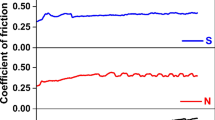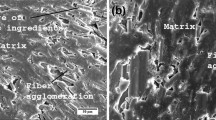Abstract
Phenol formaldehyde resin is one of the most important ingredients in friction materials that binds the other multiple ingredients firmly. The type and amount of resin in the friction material is very critical for structural integrity of the composites. The present work evaluates the influence of modification of straight phenolic resin by Nitrile Butadiene rubber (NBR) on fade and recovery behavior of friction composites developed in the laboratory. It also addresses the issue related to the variation in the amount of resin on the performance properties. The variation in amount of resin (10, 12.5, and 15 wt.%) was achieved by compensating with inert filler viz. BaSO4 (30, 27.5, and 25 wt.%) in the parent composition. Rest of the ingredients (60 wt.%) were in identical amount in all the composites. Fade and recovery studies on these composites were done according to Economic Commission for Europe (ECE) R-90 regulation. The friction coefficient (μ) (all types viz.—performance, fade and recovery), extent of fade and recovery, increase in counter-face temperature, wear and mechanical properties were significantly influenced by the modification and variation in amount of resin. It was observed that with increase in amount of resin, all types of μ decreased and extent of fade increased. Mechanical properties and wear resistance, in general, improved with increase in percentage and modification of resin. In general, it was concluded that NBR modification in straight phenolic resin resulted in improvement in some of the performance properties such as performance μ, recovery μ, and % recovery. Other properties such as fade μ and fade resistance, however, were adversely affected. No clear trends emerged in wear performance.








Similar content being viewed by others
References
Bijwe, J.: Composites as friction materials: recent developments in non asbestos fiber reinforced friction materials – a review. Polym. Compos. 18(3), 378–396 (1997)
Blau, P.J., Mclaughlin, J.C.: Effects of water films and sliding speed on the frictional behavior of truck disc brake materials. Tribol. Int. 36, 709–715 (2003)
Rhee, S.K.: Friction properties of a phenolic resin filled with iron and graphite-sensitivity to load speed and temperature. Wear 28, 277–281 (1974)
Herring, J.M.: Mechanism of brake fade in organic brake pad linings. SAE Trans., Paper No. 670146, 558 (1967)
Satapathy, B.K., Bijwe, J.: Fade and recovery behavior of non-asbestos organic (NAO) composite friction materials based on combination of rock fibers and organic fibers. J. Reinf. Plast. Compos. 24(6), 563–577 (2005)
Satapathy, B.K., Bijwe, J.: Influence of operating parameters on the performance of friction composites based on combinations of rock fibers and organic fibers. J. Reinf. Plast. Compos. 24(6), 579–595 (2005)
Satapathy, B.K., Bijwe, J.: Performance of friction materials based on variation in nature of organic fibers (part-I): fade and recovery behavior. Wear 257(5–6), 1–2, 573–584 (2004)
Gopal, P., Dharani, L.R., Blum, F.D.: Hybrid phenolic friction composites containing kevlar pulp: part I – enhancement of friction and wear performance. Wear 193, 199–206 (1996)
Gopal, P., Dharani, L.R., Blum, F.D.: Hybrid phenolic friction composites containing kevlar pulp: part II – wear surface characterization. Wear 193, 180–185 (1996)
Dong, F., Blum, F.D., Dharani, L.R.: Lapinus fiber reinforced phenolic composites: flexural and frictional properties. Polym. Polym. Compos. 4, 155–161 (1996)
Gopal, P., Dharani, L.R., Blum, F.D.: Load, speed and temperature sensitivities of a carbon fiber reinforced phenolic friction material. Wear 181–183, 913–921 (1995)
Gopal, P., Dharani, L.R., Blum, F.D.: Fade and wear characteristics of a glass fiber reinforced phenolic friction material. Wear 174, 119–127 (1994)
Kato, T., Magario, A.: The wear of aramid fibre reinforced brake pads: the role of aramid fibres. Tribol. Trans. 37, 559–565 (1994)
Handa, Y., Kato, T.: Effects of Cu powder BaSO4 and cashew dust on the wear and friction characteristics of automotive brake pads. Tribol. Trans. 39(2), 346–353 (1996)
Crosa, G., Baumvol, I.J.R.: Tribology of composites used as friction materials. In: Friedrich, K., (ed.) Advances in Composite Tribology, Composite Materials series, Vol. 8, pp. 583–628. Elsevier Science Publishers, B.V., Amsterdam (1993)
Kim, S.J., Cho, M.H., Lim, D.S., Jang, H.: Synergistic effects of aramid pulp and potassium titanate whiskers in the automotive friction material. Wear 251, 1484–1491 (2001)
Jang, H., Lee, J.S., Fash, J.W.: Compositional effects of the brake friction material on creep groan phenomena. Wear 251, 1477–1483 (2001)
Jang, H., Kim, S.J.: The effects of antimony trisulphide (Sb2S3) and zirconium silicate (ZrSiO4) in the automotive brake friction material on friction characteristics. Wear 239, 229–236 (2000)
Palmer, B.B., Weintraub, M.H.: The role of engineered cashew particles on performance. In: Intl. Conf. on Brakes 2000, Automotive Braking-Technologies for the 21st Century, Leeds, UK, 11–12 July, pp. 185–196 (2000)
Bera, S.C., Pillai, C.K.S., Rangan, P.N., Arankale, A.R., Chirmade, J.H.: Frictional and wear properties of asbestos short fibre filled phosphorylated CNSL polymers for automobile brakelining applications. Indian J. Technol. 27, 393–397 (1989)
Kim, S.J., Jang, H.: Friction and wear of friction materials containing two different phenolic resins reinforced with aramid pulp. Tribol. Int. 33, 477–484 (2000)
Zhang, Y.M., Wu, X.Q.: Proc. of Intl. conf. on Tribology – Friction, Lubrication and Wear, Queen Elizabeth-II Conference Centre, London, I Mech E, Paper No C185/87, pp. 247–250 (1987)
Izyumova, V.I., Nikonova, L.M., Chumichev, B.M.: Asbestos free friction composites to be used in automobile disc brake linings. Soviet J. Friction Wear 12, 114–117 (1991)
Bijwe, J., Nidhi, Mazumdar, N., Satapathy, B.K.: Influence of modified phenolic resins on the fade and recovery behavior of friction materials. Wear 259(7–12), 1068–1078 (2005)
Bijwe, J., Nidhi, Satapathy, B.K.: Influence of amount of resin on fade and recovery behavior of non-asbestos organic (NAO) friction materials. Trans. Indian Inst. Met. 57(4), 335–344 (2004)
Nidhi, Bijwe, J., Majumdar, N.: Influence of amount and modification of resin on fade and recovery behavior of non-asbestos organic (NAO) friction materials. Tribol. Lett. 23(3), 215–222 (2006)
Knop, A., Pilato, L.A.: Phenolic Resins: Chemistry, Applications and Performance. Springer-Verlag, Berlin (1985)
Briscoe, B.J., Tweedale, P.J.: Aramid fibre friction: a replacement for asbestos in high friction materials. In: Rohtagi, P.K., Blau, P.J., Yust, C.S. (eds.) Proceedings of the Conference on Tribol. of Compos. Materials, May 1–3, 1990, pp. 251–263. ASM Intl., Materials Park, OH (1990)
Acknowledgment
Authors gratefully acknowledge Department of Science and Technology (Govt. of India) for funding this work.
Author information
Authors and Affiliations
Corresponding author
Rights and permissions
About this article
Cite this article
Nidhi, Bijwe, J. NBR-modified Resin in Fade and Recovery Module in Non-asbestos Organic (NAO) Friction Materials. Tribol Lett 27, 189–196 (2007). https://doi.org/10.1007/s11249-007-9225-x
Received:
Accepted:
Published:
Issue Date:
DOI: https://doi.org/10.1007/s11249-007-9225-x




